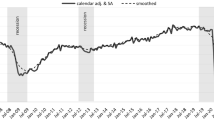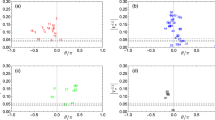Abstract
The accurate assessment of business conditions is a long-standing problem in macroeconomics. To construct a coincident index of growth cycles from a given set of indicators, we propose a new approach: the co-movement of cyclical components (triple-C) approach. For realizing the triple-C approach, we introduce a multi-objective optimization algorithm. We refer to the coincident index of growth cycles as the index of business cycles (IBC) of coincident economic indicators. The IBC based on the triple-C approach has the following properties: (1) its mean is globally stationary; (2) it is constructed as a common factor in the stationary parts of the selected economic indicators; and (3) its variations are as large as possible so that it contains a relatively large amount of information for business cycle analysis. We examine the performance of the constructed IBC by comparing it with a composite index based on data for coincident indicators in Japan.









Similar content being viewed by others
References
Baxter, M., & King, R. (1999). Measuring business cycles: Approximate band-pass filter for economic time series. The Review of Economics and Statistics, 81, 575–593.
Burns, A. F., & Mitchell, W. C. (1946). Measuring business cycles (Vol. 2). New York: National Bureau of Economic Research.
Fukuda, K. (1994). On measuring business conditions. JCER Economic Journal, 27, 17–38. (in Japanese).
Fukuda, S., & Onodera, T. (2001). A new composite index of coincident economic indicators in Japan. International Journal of Forecasting, 17, 483–498.
Friesz, T. L. (1992). Hierarchical optimization: An introduction. Annals of Optimization Research, 34, 1–11.
Girardin, E. (2004). Regime-dependent synchronization of growth cycles between Japan and East Asia. Asian Economic Papers, 3, 147–176.
Girardin, E. (2005). Growth-cycle features of East Asian countries: Are they similar? International Journal of Finance and Economics, 10, 143–156.
Hamilton, J. (1989). A new approach to the economic analysis of nonstationary time series and the business cycle. Econometrica, 57, 357–384.
Han, Y., Liu, Z., & Ma, J. (2020). Growth cycles and business cycles of the Chinese economy through the lens of the unobserved components model. China Economic Review, 63, 101317.
Harding, D., & Pagan, A. (2005). A suggested framework for classifying the modes of cycle research. Journal of Applied Econometrics, 20, 151–159.
Hodrick, R. J., & Prescott, E. C. (1997). Postwar US business cycles: An empirical investigation. Journal of Money, Credit and Banking, 29, 1–16.
Kaihatsu, S., Koga, M., Sakata, T., & Hara, N. (2019). Interaction between business cycles and economic growth. Monetary and Economic Studies, 37, 99–126.
Kanoh, K., & Saito, S. (1994). Extracting actuality from judgement: A new index for the business cycle. Monetary and Economic Studies, 12, 77–97.
Kariya, T. (1988). MTV model and its application to the prediction of stock prices. In T. Pullila & S. Puntanen (Eds.), Proceedings of the second international Tampere conference in statistics (pp. 161–176). University of Tampere.
Kariya, T. (1993). Theory and practice of econometric analysis. Toyo Keizai. in Japanese.
Kim, C. J., & Nelson, C. R. (1998). Business cycle turning points, a new coincident index, and tests of duration dependence based on a dynamic factor model with regime-switching. The Review of Economics and Statistics, 80, 188–201.
Kitagawa, G. (1981). A non-stationary time series model and its fitting by a recursive filter. Journal of Time Series Analysis, 2, 103–116.
Kitagawa, G. (2020). Introduction to time series modeling with application in R (2nd ed.). Chapman and Hall.
Kitagawa, G., & Gersch, W. (1984). A smoothness priors state space modeling of time series with trend and seasonality. Journal of the American Statistical Association, 79, 378–389.
Komaki, Y. (2001). The prediction of cyclical turning points: In applying the turning-point prediction models to the Japanese economy. Financial Review, 57, 42–69. (in Japanese).
Kyo, K., & Noda, H. (2011). A new algorithm for estimating the parameters in seasonal adjustment models with a cyclical component. ICIC Express Letters, 5, 1731–1737.
Ma, J., & Wohar, M. E. (2013). An unobserved components model that yields business and medium-run cycles. Journal of Money, Credit and Banking, 45, 1351–1373.
Mariano, R., & Murasawa, Y. (2003). A new coincident index of business cycles based on monthly and quarterly series. Journal of Applied Econometrics, 18, 427–443.
Mariano, R., & Murasawa, Y. (2010). A coincident index, common factors, and monthly real GDP. Oxford Bulletin of Economics and Statistics, 72, 27–46.
Morley, J. C., Nelson, C. R., & Zivot, E. (2003). Why are the Beveridge–Nelson and unobserved-components decompositions of GDP so different? The Review of Economics and Statistics, 85, 235–243.
Ohkusa, Y. (1992). Constructing a stochastic business index in Japan. Doshisha University Keizaigaku Ronso, 44, 25–60. (in Japanese).
Stock, J. H., & Watson, M. W. (1989). New indexes of coincident and leading macroeconomic indicators. In O. Blanchard & S. Fischer (Eds.), NBER macroeconomics annual (pp. 351–394). MIT Press.
Stock, J. H., & Watson, M. W. (1991). A probability model of the coincident economic indicators. In K. Lahiri & G. Moore (Eds.), Leading economic indicators: New approaches and forecasting records (pp. 63–89). Cambridge University Press.
Urasawa, S. (2014). Real-time GDP forecasting for Japan: A dynamic factor model approach. Journal of the Japanese and International Economies, 34, 116–134.
Watanabe, T. (2003). Measuring business cycle turning points in Japan with a dynamic Markov switching factor model. Monetary and Economic Studies, 21, 35–68.
Zarnowitz, V. (1991). What is a business cycle? NBER Working Paper 3863.
Zarnowitz, V., & Ozyildirim, A. (2006). Time series decomposition and measurement of business cycles, trends and growth cycles. Journal of Monetary Economics, 53, 1717–1739.
Acknowledgements
The authors gratefully acknowledge the anonymous reviewers for their constructive comments and suggestions, which have made this article more valuable and readable. This work was supported in part by a Grant-in-Aid for Scientific Research (B) (18H03210) and a Grant-in-Aid for Scientific Research (C) (19K01583) from the Japan Society for the Promotion of Science. We thank Maxine Garcia, PhD, from Edanz (https://jp.edanz.com/ac) for editing a draft of this manuscript. We would like to thank also the anonymous reviewers for their constructive comments and advice.
Author information
Authors and Affiliations
Corresponding author
Additional information
Publisher's Note
Springer Nature remains neutral with regard to jurisdictional claims in published maps and institutional affiliations.
Rights and permissions
About this article
Cite this article
Kyo, K., Noda, H. & Kitagawa, G. Co-movement of Cyclical Components Approach to Construct a Coincident Index of Business Cycles. J Bus Cycle Res 18, 101–127 (2022). https://doi.org/10.1007/s41549-022-00067-9
Received:
Accepted:
Published:
Issue Date:
DOI: https://doi.org/10.1007/s41549-022-00067-9
Keywords
- Business cycle index
- State space model
- Growth cycles
- Composite index
- Co-movement of cyclical components
- Decomposition of time series




